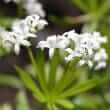Background
- Sweet woodruff was widely used in herbal medicine during the Middle Ages, gaining a reputation as an external application to wounds and cuts and also taken internally in the treatment of digestive and liver problems. Today, it is valued mainly for its tonic, diuretic and anti-inflammatory affects.
- It is native to Europe where it can be found from the Scandinavian countries to Britain. It is very popular in Germany where it is called Waldmeister or Master of the Forest. Sweet woodruff leaves are commonly used to flavor May wine in Germany and the U.S. Food and Drug Administration (FDA) considers sweet woodruff safe when taken in alcoholic beverages.
References
- Kovac-Besovic EE, Duric K. Thin layer chromatography-application in qualitative analysis on presence of coumarins and flavonoids in plant material. Bosn J Basic Med Sci 2003;3(3):19-26.
View Abstract - Sulma T, Wierzchowska K. [Studies on the content of coumarin in the herbs of the woodruff (Herba Asperulae odoratae) throughout the vegetative period of the plant.]. Acta Pol Pharm 1963;20:77-82.
View Abstract - U.S. Food and Drug Administration (FDA). Flavoring Agents and Related Substances. 2005;
- Wierzchowska-Renke K. [Study of the content of 1-ascorbic acid in the herb Asperulae odoratae L. depending on the stage of its development in the period of vegetation]. Acta Pol Pharm 1969;26(2):181-185.
View Abstract







